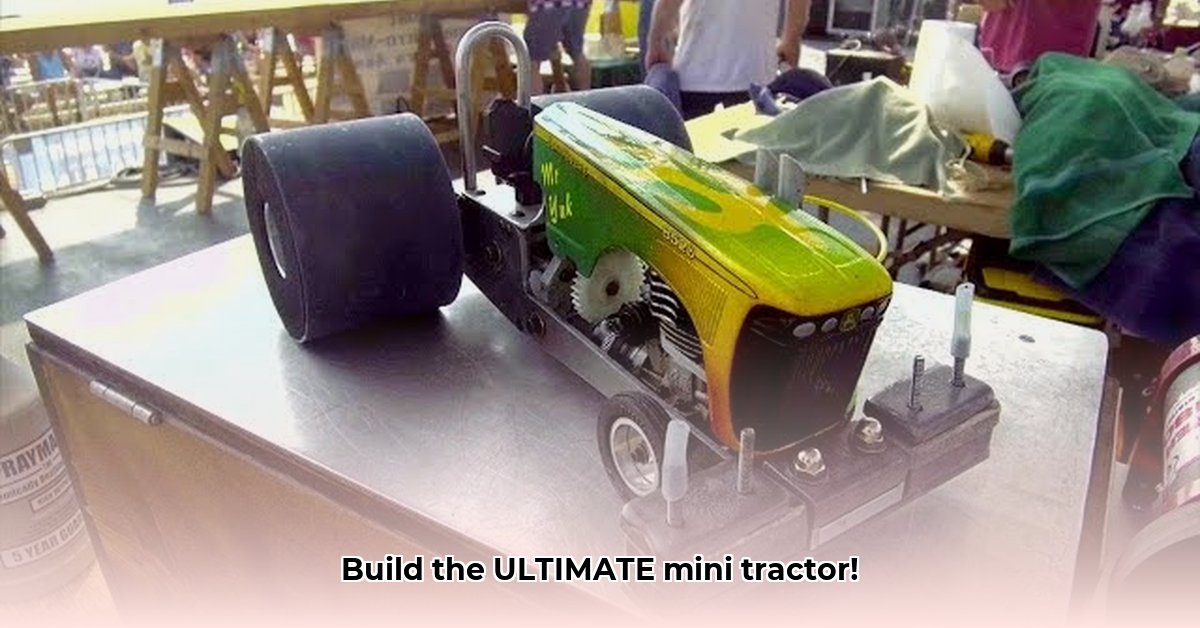
Miniature tractor pulling—a thrilling blend of engineering, skill, and competition—challenges participants to build powerful, compact machines capable of incredible feats of strength. This guide provides actionable intelligence for both novices and seasoned competitors, covering key components, modification strategies, and essential maintenance for achieving peak performance and safety. For more inspiration, check out this pedal tractor example.
Key Components: The Heart of Your Pulling Tractor
Understanding the critical components of your miniature pulling tractor is paramount to success. Each part plays a vital role in generating pulling power and ensuring stability. Let’s explore the essentials:
Engine: The Powerhouse
The engine is the heart of your tractor, providing the raw power for pulling. A robust, high-performance engine is crucial. Consider factors such as horsepower, torque, and reliability when making your selection. (Horsepower is a measure of engine power; torque is a measure of rotational force). Engine modifications—discussed later—can significantly enhance performance, but always prioritize reliability.
Transmission: Power Transfer Specialist
The transmission is responsible for efficiently transferring power from the engine to the wheels. A well-chosen transmission allows for optimal gear ratios, maximizing pulling force while maintaining control. Different types of transmissions (manual, automatic, etc.) offer varying advantages and disadvantages. Understanding the nuances of gear ratios is crucial for optimizing your tractor's performance in various conditions.
Chassis: The Structural Backbone
The chassis provides the structural integrity of your tractor. A strong, well-designed chassis is essential for withstanding the immense forces generated during pulling. Consider using high-strength materials and reinforcing critical areas to prevent failures. Chassis design directly impacts the tractor's stability and maneuverability.
Tires: The Ground Connection
Tires are the crucial interface between your tractor and the pulling surface. Choosing the right tires is vital for maximizing traction and grip. Larger tires generally offer better grip, but regulations may limit the size. Proper tire inflation is also critical for optimal performance and safety. (Tire pressure affects traction and handling).
Weight Distribution: The Balance Factor
Strategic weight distribution plays a critical role in a pulling tractor's performance and stability. Proper weight distribution ensures optimal traction and minimizes the risk of wheel spin or tipping. Experimentation and meticulous adjustment are key to finding the ideal balance. (A balanced weight distribution improves stability and traction).
Modification Strategies: Fine-Tuning for Peak Performance
Modifying your miniature pulling tractor can unlock significant performance gains. However, always prioritize safety and adhere to competition regulations. Carefully planned modifications can dramatically improve your tractor's pulling power and efficiency.
Engine Tuning: Unleashing Hidden Power
Engine tuning involves optimizing various parameters like fuel delivery, ignition timing, and air-fuel mixture to maximize horsepower and torque. This requires a precise, methodical approach and detailed knowledge of internal combustion engines. Incorrect tuning can damage the engine. Consult experienced mechanics for assistance.
Chassis Reinforcement: Enhancing Durability
Reinforcing the chassis involves strengthening weak points to prevent failures under stress. This can involve welding additional supports, using high-strength materials, or incorporating structural reinforcements to the existing frame. (Consider using steel or aluminum alloys). A stronger chassis leads to increased safety and reliability.
Weight Balancing: Optimizing Performance
Fine-tuning weight distribution can dramatically improve traction and stability. Careful placement of weight, considering the center of gravity, can significantly enhance your tractor's pulling capability. (Experiment to find the optimal balance point). This process requires careful measurement and adjustment.
Review of Popular Tractors and Parts
The market features many miniature pulling tractor brands and parts manufacturers. Researching different brands and models is crucial to finding the right fit for your needs and budget. Online forums and classifieds (like RacingJunk) are excellent resources for finding parts and getting advice from fellow enthusiasts.
Safety and Maintenance: Prioritizing Safety and Longevity
Safety and regular maintenance are paramount. Always wear appropriate safety gear (eye protection, gloves, closed-toe shoes). Regular inspections, oil changes, and filter replacements are essential for maintaining optimal performance and preventing accidents. (Regular maintenance extends the lifespan of your tractor).
Conclusion: Join the Thrill of the Pull
Building and competing with miniature pulling tractors is an exciting hobby combining engineering, skill, and teamwork. This guide serves as a foundation; continuous learning and practical experience are key to becoming a successful competitor. Join your local miniature tractor pulling club and enjoy the unique challenge and rewarding thrill of the sport! [Link to NMMTPA website].
Key Takeaways:
- Weight reduction is crucial for improved performance.
- Engine upgrades significantly boost pulling power but must comply with regulations.
- Tire selection and inflation are critical for maximum traction.
- Chassis strength is paramount for safety and reliability.